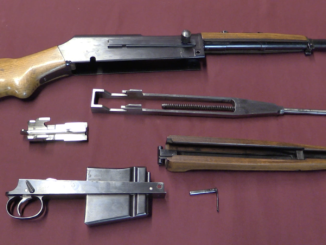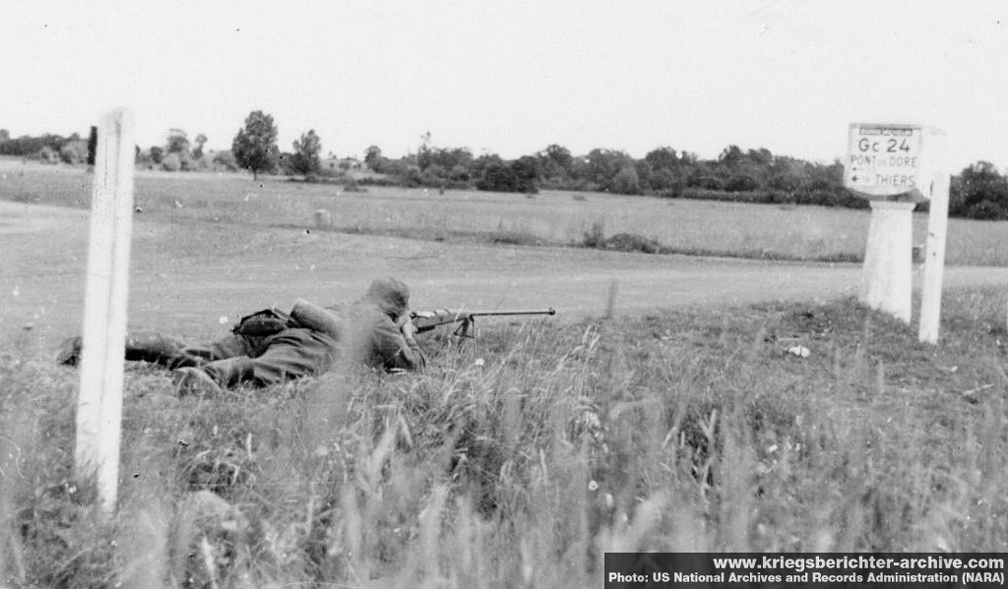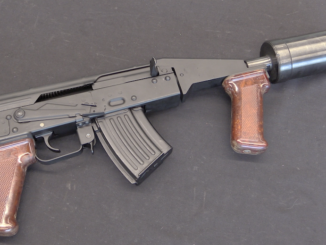In the early 1970s, Poland wanted to replace their 7.62x39mm Kalashnikov rifles. The Soviet Union was developing the 5.45mm AK-74, but the Poles wanted to make a more ambitious advance in small arms systems. They launched Project Lantan (Polish small arms programs were code named after minerals and periodic table elements). The plan was to create a modular system similar in concept to the Stoner 63 – a single universal receiver that could be fitted with different components to create variety of weapons. These could include a short carbine, infantry rifle, mag-fed light machine gun, squad automatic, or vehicular machine gun (fired by spade grips or remote solenoid).
The cartridge developed for the rifle was an indigenous 7x41mm round that was longer and more efficient than 7.62x39mm. Two prototype rifles were built, and courtesy of Works 11 in Katowice, Poland we have a chance to take a close look at number 1. Unfortunately its experimental foam/rubber stock has completely disintegrated in the past 50 years since it was built, but the rest of the rifle is intact. It features separate upper and lower receivers and a quick-change barrel and gas tube.
Once the Soviet Union found out about the project, they forced it to be cancelled. The Soviets wanted caliber commonality within the Warsaw Pact, and they also wanted to collect a license fee from Poland for the AK-74 and 5.45x39mm cartridge. In this they were only partially successful, as the Poles reverse engineered elements of the AK-74 to create their own unique Tantal rifle design instead of licensing the new Kalashnikov. But even so, the Lantan project was squashed before it could advance beyond two initial proof of concept rifles.
Thanks to Works 11 and all my other friends in Poland who helped arrange access to this fascinating rifle!




I remember a comment of Ian Hogg’s that every time a committee of the great and good is tasked with coming up with the ideal caliber for infantry use, they come up with 7mm AND THEN something (like a World War) comes along and prevents its adoption. Here is another for the long list.
Collecting royalties….How capitalist of them ! (If you want a real story of Soviet capitalism look at what they charged their “Socialist Brothers and Sisters” for their cast off junk (remember, the Russians never throw away ANYTHING, to get an idea of what was being foisted on the Spaniards) during the Spanish Civil War
Back in the ’80s I read a study on Warsaw Pact terms of trade, meaning quantification of who was really profiting from Soviet trade with its satellites. The data was over my head, but the conclusion was that at first the terms were very biased in Soviet favor. Over the decades, it got harder and harder for them to strongarm their satellites, who were getting more technologically advanced than them in some areas and were also trading with the West. This story of how 1970s Poland worked angles until it got out of those AK fees was another warning sign of what was coming.
“(…)Warsaw Pact terms of trade(…)” mentioned Pact was military, you are probably meant earlier created Council for Mutual Economic Assistance and relations between their fullmembers https://en.wikipedia.org/wiki/Comecon#Exchange
Its possible story/comment is not true, as many such ex. warsaw pact countries could claim beef for soviets supposedly forcing them this and that (when in fact their dictatorship governments did something themselves)
More accurately the Soviets always liked to keep their satellite states about one generation behind on armaments, lest they get ideas about revolting. Soviets had the AK-47, Warsaw Pact got the SKS for 20-odd years. Same situation with tanks, USSR gets the T-80s while everyone else has mixed T-54/55s and T-72s, etc.
“(…)indigenous 7x41mm round(…)”
Dimensions can be seen here https://naboje.org/node/10618
“(…)single universal receiver that could be fitted with different components to create variety of weapons(…)”
Bit earlier Czechoslovak engineer developed URZ
https://modernfirearms.net/en/assault-rifles/urz-plamen-2/
unlike Polish weapon it used existing cartridge (7,62×51) and was made for export
“(…)Soviet Union found out about the project, they forced it to be cancelled.(…)”
Independently from that, this weapon apparently featured drawback common for similar modular fire-arms of that time: if you made receiver sufficient for machine gun it is blatantly heavy for short-barreled carbine, if you made receiver light for usage as short-barreled carbine it will poorly worked when used intensively in machine gun role.
The barrel-change mechanism is pretty interesting though.
Are their any photographs of the ammunition or rifle parts available for the viewers of this article?
https://cartridgecollector.net/cartridge/7-x-41-lantan/
Note the immense size of the receiver compared to the AK.
The cartridge is very like the Czech 7.62 x 45mm round of the Vz52 rifle. The Vz52/57 is of course the same rifle chambered for 7.62 x 39.
Somehow the Lantan reminds me irresistibly of the “steampunk” rifles in The League of Extraordinary Gentlemen (2003). Those were Uzis and TSMGs inside fake outer casings;
https://www.imfdb.org/wiki/League_of_Extraordinary_Gentlemen,_The
cheers
eon
Dont forget funky stens from Nemos submarine!
Movie was trashy, but I liked it.
speaking of soviet capitalism and greed, there’s a Polish joke for you: what did we (Poles) get as a gift from the Soviet Union for Polands national day? A train. A train to be filled with goods a shipped to mother Russia.
– this was actually kind of true; there was a wide track railway running from the Soviet border to the very entrails of the most important Polish industrial region:
https://en.wikipedia.org/wiki/Linia_Hutnicza_Szerokotorowa
(long defunct, at least officially, although I would not be surprised if good people do not use it now to send good stuff to Ukraine…)
I wonder how long it would have taken for the Poles to return a heavier cartridge to the MG section, and what it would have been.
I remain darkly amused at how many of these “One cartridge to rule them all” schemes fail, despite the best intentions and all the money lavished on them. Poland may well have cause to be grateful to the Soviet Union for putting an end to this before they got too deep down the rabbit hole…
I repeat and reiterate: The cartridge that serves best in an individual weapon almost certainly cannot, with current technology, serve even marginally in the support weapon role where you really need the power and range.
You can speculate all you like, but until the materials and propellant categories allow it, that’s a harsh truism. I could see a couple of ways of overcoming it all, but the current state of the art wouldn’t support the ideas I have.
I’m going to go out on a limb and say the two best HMG cartridges ever concocted were the Italian 8 x 59mm Breda and the Swedish 8 x 63mm.
Both showed roughly .300 H & H Magnum ballistics and were accurate and lethal out to 1,200 meters. At 1,000 meters, either one would thoroughly kill a truck’s engine.
Only the Swedish Army tried to put theirs into a rifle. They issued Mauser 98Ks in 8 x 63mm to their machine gun troops using Browning MGs in 8 x 63mm. They had muzzle brakes and definitely needed them.
PS- No, the American 8mm-06 wildcat and the 8 x 63mm Swedish are not the same cartridge and are not even remotely interchangeable.
clear ether
eon
“(…)Only the Swedish Army tried to put theirs into a rifle.(…)”
False, Italians, namely Pavesi, also crafted rifle for their MG cartridge, although it was self-loading, see photos https://www.forgottenweapons.com/pavesi-prototype-svt-copy-video/
“I remain darkly amused at how many of these “One cartridge to rule them all” schemes fail, despite the best intentions and all the money lavished on them.”
Ironically, Dr. Gunther Voss made a cartridge that overcomes the recoil issue for full powered cartridges, that is the 7.92x40mm CETME. I agree, I don’t know why countries are bothering with 6-7mm intermediates when Voss already made a full powered cartridge controllable in full-auto while also having the same ballistics as the 7.62mm NATO.
Other than the NATO adoption of 7.62X51, nobody seems to have a good reason for why they didn’t adopt this cartridge. And, it died on the vine, without further development, which makes you wonder why nobody else tried something like it, later on.
One does wonder how it would have performed loaded for tracer and all the other special-purpose rounds required for the full spectrum of operations.
Yet another road not travelled due to the politics of alliances and the 800-pound US procurement gorilla. The various worthies of the US Ordnance Department have a lot to answer for.
Your agreement with me only serves to mark your genius… 😉
I’ve long felt that the ideal cartridge pairing would have been a 6.5 Swedish reduced just enough to make it controllable on fully automatic, and their 8X63 in the support role…
.338 Norma is just a bit too heavy for my taste… 100 rounds is nearly two pounds more than 100 in 7.62 NATO, and that’s a burden I don’t see going well on the backs of the infantry. Vehicles? Sure, but if you’re going to do that, why not go whole-hog and use .50 caliber?
This was supposed to be a reply to Eon’s post at 2:19pm…
In the Western Desert campaign, the British would use any Italian Breda Mo37 in 8 x 59 they could get, both due to the cartridge’s range, accuracy and lethality and due to the Mo37 HMG’s brute reliability. Granted, its setup of a 25 round feed tray the empty case was reinserted into after firing was a little weird, but it did eliminate the whole belt lift problem that dogged most HMGs.
The Swedish 8 x 63 Browning was their version of the m1919 .30. It was designed for use by ski troops, had a rather odd-looking bipod, and so was probably light enough to be a bit “lively” when fired even in short bursts.
There was also a heavy-barreled version with a tripod not unlike that of the German MG34, that could be set up and laid in properly for long-range work.
The Breda Mo37’s tripod looked rather like that for the British Bren, which I guess was copied from one for the original Zb26. This might explain why the LRDG tended to bolt the Breda on the pipe mount in the back of the Chevrolet WD 30 30cwt truck.
cheers
eon
The backers of the .338 Norma say that their cartridge is more accurate at long range than the .50 Browning. I’d admire to see some competitive testing of that claim.
There’s a notable lack of repeatable experimentation or verifiable documentation that gets shared with all of this “cartridge wars” crap.
Most of the arguments boil down to subjective impressions, and the evidence presented simply isn’t verifiable or repeatable by other parties, which basically means “It ain’t science…”
Rather like the whole “Handgun Stopping Power” debate of days gone by. People coming up with “formulas” that all showed their favorite cartridge was the only one that worked.
A few years ago Gun Digest had an article describing a research project on the subject of “which handgun has killed more men than any other?”
They concluded that the winner was the P.08, with the M1911 .45 and the Colt M1873 tied for second place.
However, when you looked at the actual data, all they’d achieved was to show that between pistols, SMGS and etc., more “men” had been fatally shot with 9 x 19mm ammunition from 1906 to 2006 than had been equivalently done by .45 ACP, .45 Colt, .44-40 WCF, and etc.
That’s still about three times the verifiability/falsification level of things like the FBI’s “Computer Man”, Sanow & Co.’s “One Shot Stop” efforts, and etc. It’s certainly far above Hatcher or Cooper or Taylor’s level of research.
The people who would be the most qualified to actually do such work will never do it. Mostly due to ingrained hoplophobia.
Science needs to be impartial, in this as in any other area. Meaning, no starting with a result you want, and then cherry-picking data to “support” your “conclusion”.
The fact that the latter method is preferred today is the main reason that “science” has become a secular religion, as opposed to a way to figure out how the world actually “works”.
clear ether
eon
I think it’s really amazing how many times you run into things like “Yeah, everyone says we ought to have a 6.5mm individual weapons cartridge with around these ballistic properties as the ideal solution, yet nobody has ever adopted any such thing…”
It isn’t just here, either. I can think of a bunch of other cases where people have said similar things in other technical areas, and yet… The “ideal solution” never, ever seems to get adopted. It’s like the Dvorak keyboard layout vs. the QWERTY one; all the “smart people” agree that Dvorak is better, yet… Here we all are, using QWERTY.
You keep running into this, just about everywhere. I’m starting to wonder if there’s something else, some universal principle, some over-riding influence on reality that we’re all just… Missing.
Kirk;
One of my profs (ex-Agency) said “The problem is that in a bureaucracy, everybody guards their fiefdom”. At Langley he got very familiar with that.
I think overall it’s even more basic. Put simply, everybody wants to be God, and they believe that God doesn’t change His mind.
The Old Testament stories (the Flood, Sodom and Gomorrah, etc.) would tend to contradict this hypothesis.
cheers
eon
“there’s something else, some universal principle, some over-riding influence on reality that we’re all just… Missing.”
Maybe https://en.wikipedia.org/wiki/Worse_is_better ?
Otherwise known as “The installed base always wins…”, I suppose.
Which still doesn’t explain why, whenever they go looking for a clean-sheet design, they wind up not doing what everyone agrees is the optimal solution…
Problem with 6.5 is that’s traditional (even more, because that “ideal cartridge” ends to have muzzle energy levels comparable to well over 100 years old ones), but not traditional in the US.
So the advocates of the “trusted and true”, in the US, want .30, because .30 won two world wars. While the supporters of innovation want something that’s NOT .30 nor 6.5, (at the cost of doing it 6.8). Because the old solution, being it American or someone else’s can’t be the correct one.
“(…).338 Norma is just a bit too heavy(…)”
Then consider using .338 cartridge for .338 Dillon Aero rotary machine gun, see photos
https://soldat-und-technik.de/2020/01/bewaffnung/18052/shotshow-2020-dillon-aero-stellt-gatling-gun-in-338-vor/ which to my understanding should be lighter